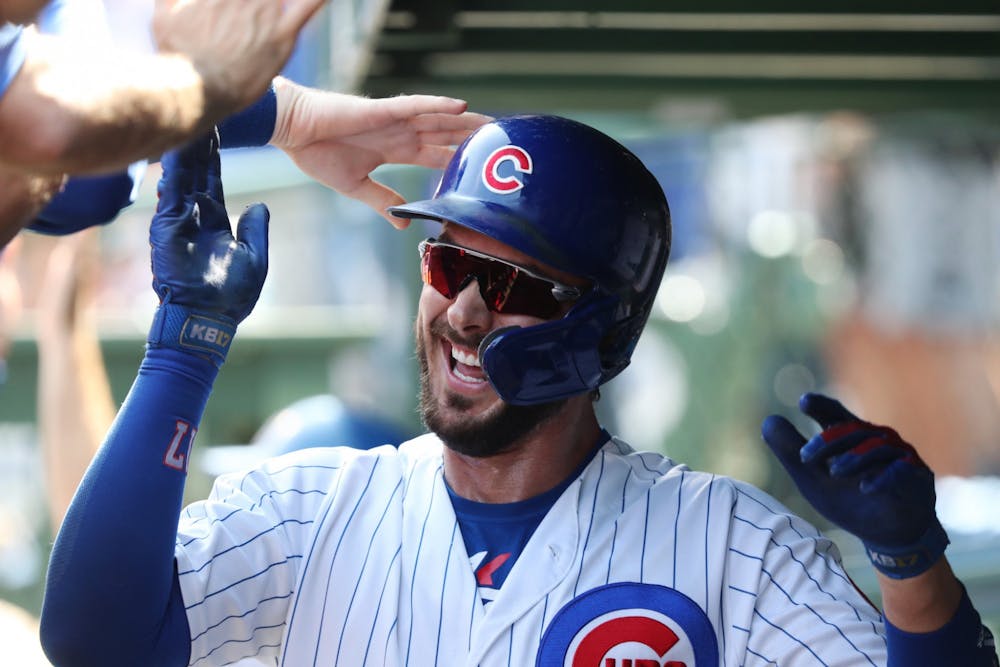ESPN’s Jeff Passan reported Wednesday morning that Chicago Cubs third baseman Kris Bryant — after trying to enter free agency this season — has lost his grievance against the team and will play an extra year of service time.
The ruling was expected, and Bryant will now have to wait until after the 2021 season to become a free agent.
The Cubs did not have Bryant on their opening-day roster in 2015 despite being the consensus Minor League Player of the Year in 2014. That season, Bryant led MLB with 43 home runs, 78 extra-base hits, a .661 slugging percentage and 1.098 on-base plus slugging.
Even after a strong spring training and ranking as the second-best prospect in the 2015 preseason, the Cubs waited until April 17 to bring Bryant to the senior circuit.
If the Cubs brought Bryant up a day prior, he would have been in the majors for 172 days, the minimum for a full year of MLB service time. This would have put him on track to be eligible for free agency after the 2020 season.
Instead, Bryant can’t be a free agent until 2021 since he only received 171 days of service time despite winning the National League Rookie of the Year and leading Chicago to the National League Championship Series in 2015.
Service time, on paper, is actually quite simple. It is the amount of time a player has spent on a Major League Baseball team.
However, Bryant’s case was built around the accusation that the Cubs manipulated his service time in MLB's arbitration system. According to MLB, for a player to become a free agent he must accumulate six full seasons of service time.
The Bryant case is a perfect example of how MLB teams manipulate service time to their advantage to keep control of top prospects for an extra season. While the Cubs participated in a shady practice and are morally wrong in the Bryant case, they are just one team in a long list to skew the rules in their favor.
Another instance came in 2019 with the Toronto Blue Jays and third baseman `Vladimir Guerrero Jr. Guerrero was the top prospect in baseball, but Toronto kept him in triple A Buffalo until April 27, which was just late enough for the club to keep Guerrero under team control through 2025 instead of 2024.
The Atlanta Braves performed the same tactic in 2018 to delay top prospect Ronald Acuña’s Major League debut until late April. He finished with 159 days of service time on the season.
Similar examples also include George Springer recording 166 days of service time in 2014, Bryce Harper with 159 in 2012 and Evan Longoria being active 171 days with Tampa Bay in 2008.
In addition to delaying players from becoming free agents, service time manipulation limits the amount of money star players make while they go through the arbitration system. MLB arbitration is how player salaries are determined for players who have more than three and less than six years of service time, with the exception of “Super Two” players that begin arbitration after two seasons of service time.
The process involves the club and the player determining a player’s salary for the upcoming season. If they fail to do so by mid-January, the two parties meet with an arbiter who either agrees with the club’s contract offer or the player’s decided salary.
The issue is that through renewable contracts and then the arbitration system, star players often make far less than they are worth. For players that saw their service time manipulated, it adds an extra year of unfair pay.
Between 2015-19, Bryant made roughly $25.9 million. While that seems like a ton of cash, and I would personally love to have just a tiny fraction of it, Bryant is still incredibly underpaid.
According to FanGraphs player financial worth calculator, Bryant’s value for the last four seasons is $222.4 million.
Fixing MLB’s service time issues is not easy. It’s going to be a huge point of contention between players and owners when the Collective Bargaining Agreement expires in 2021. It’s up to the league to work with the players association to try to find a better method to pay young players than the current mess.






